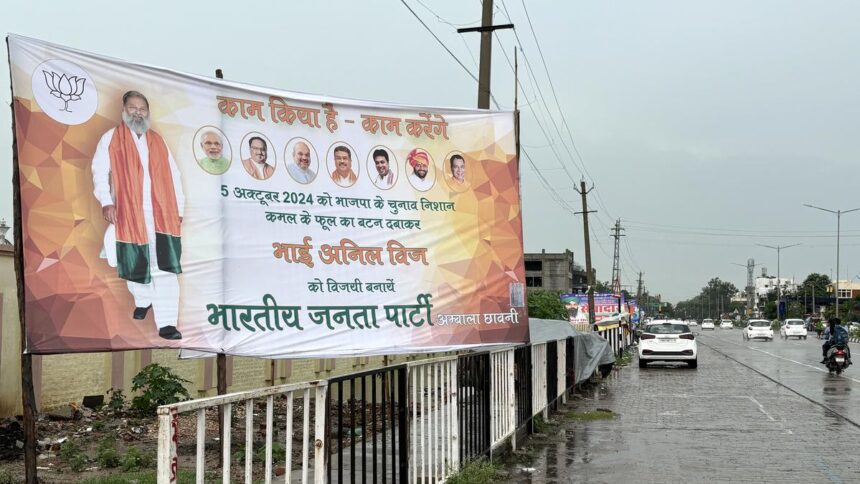Gurdeep Lal examines a small booklet he received in 2015 from the Haryana Building and Other Construction Workers Board. It outlines 22 welfare programs designed to support individuals through various life circumstances, including death. In the nine years since he joined the program, he expresses frustration that he has yet to benefit from any of these initiatives.
At 39, Mr. Lal belongs to the Baazigar community and operates a grocery store in Chapra village within Haryana’s Shahbad Assembly constituency. As a Scheduled Caste voter, he has become a focal point for major political parties ahead of the upcoming elections in the state.
As he skims the promises of financial aid in the booklet—₹51,000 for the wedding expenses of daughters, ₹3,000 for a bicycle purchase, ₹3,500 for a sewing machine, and ₹15,000 for the family of a deceased registered worker for last rites—he recounts the numerous trips he made and the extensive paperwork he needed to provide just to apply for the bicycle scheme. Ultimately, he abandoned the effort. “It wasn’t worth sacrificing so many workdays,” remarks Mr. Lal.
A grain market at Karnal district, Haryana
| Photo Credit:
Sabika Syed
Many others in his vicinity resonate with his sentiments, sharing similar stories. “The underprivileged are bogged down by the paperwork. We receive nothing,” Mr. Lal adds.
For the typical Dalit voter grappling with the documentation needed to qualify for various welfare schemes from both the State and Central governments, there is little tolerance for political rhetoric. Initiatives like the Parivaar Pechchaan Patra (Family ID), which was launched with great enthusiasm by former Chief Minister Manohar Lal Khattar, have left many potential beneficiaries feeling disillusioned. A shared sentiment echoes through their complaints: a strong desire for change.
The Congress has solidified its standing as the preferred political choice for Jat voters in this election, while the BJP aims to unify the diverse OBC voter base and create an anti-Jat coalition. Amid this political tug-of-war, the 21% of voters from SC communities could play a pivotal role. With polling imminent in Haryana, the BJP and Congress are both intent on showcasing their support for Dalits.
Randhir Leelaram, aged 65, a member of the Chamar community from Kohaad village near Karnal, expresses his frustration. He pulls out three frayed electricity bills from his wallet, with the latest amounting to ₹18,000. As he gestures toward his small plot that yields paddy, he inquires, “How can I possibly afford this?”
Banners related to upcoming election can be seen at Karnal district in Haryana.
| Photo Credit:
Sabika Syed
However, this is not his first encounter with bureaucratic hurdles. “Today, it’s about the electricity bill; yesterday, it was the Family ID. We are continually entangled in red tape,” he asserts. He believes that regardless of which party takes power, individuals like him experience only minor improvements in their lives. “But the Congress at least did something for us. For the past ten years, our concerns have gone unheard,” he insists.
In prior elections in Haryana, outcomes have frequently been determined by which party secures the most seats designated for SC candidates. In 2014, during the BJP’s most successful electoral campaign in the state, the party claimed nine out of the 17 reserved seats, boosting its overall count to 47. By 2019, the Congress reversed its fortunes, doubling its representation in the Legislative Assembly to 31, capturing seven of the reserved constituencies.
Congress insiders maintain that if the party’s recent general election performance—where it secured five out of ten Lok Sabha seats—is reflected in Assembly constituencies, it could gain an advantage in 11 out of the 17 reserved seats.
Darshana, aged 45, has just returned home after her morning shift as a domestic worker. A member of the Valmiki community from Mullana, a small town near Ambala, she has consistently voted for the Congress. While she is cautious about discussing her political views, she is eager to voice her concerns regarding rising vegetable prices and essential goods. “Everything costs more, yet our wages remain stagnant,” she highlights. Regarding her voting decision, she is resolute. “Under Congress, we found employment opportunities. My husband secured work as a sweeper with the state government. But my son struggles day by day,” she laments.
While the Congress hopes to build upon its prior successes, the BJP has been actively attempting to undermine its reputation. Recently, both Prime Minister Narendra Modi and Home Minister Amit Shah have publicly criticized the Congress, branding it an anti-Dalit party. The Congress’s leading Dalit figure in the state is Lok Sabha MP Kumari Selja, who has largely refrained from campaigning due to her dissent over her political rival and former Chief Minister Bhupinder Hooda having greater influence over candidate selections. This situation has provided the BJP with additional leverage against the Congress. Nevertheless, in recent days, the Congress has managed to stabilize its position, with Ms. Selja appearing alongside Mr. Hooda and Leader of Opposition Rahul Gandhi at a public gathering in Jind district.
Dushyant Chautala’s Jannayak Janata Party (JJP), in coalition with Chandrashekhar Azad’s Azad Samaj Party (ASP), along with the Indian National Lok Dal (INLD) partnering with the Bahujan Samaj Party (BSP), are also competing for the Dalit vote.
In Chamar Khera, located within the Indri Assembly constituency, the village entrance is adorned with bunting and posters from both the Congress and BSP. Village sarpanch Ram Jawari takes a practical stance on the elections. “Both the BSP and ASP have allied with Jats. These coalitions aim to fragment the Dalit vote and prevent a consolidation toward the Congress. However, they seem to overlook that we cannot be deceived. What benefit is there in voting for someone who merely perpetuates the status quo? We seek change,” asserts Mr. Jawari.
Published – September 27, 2024 08:07 pm IST










